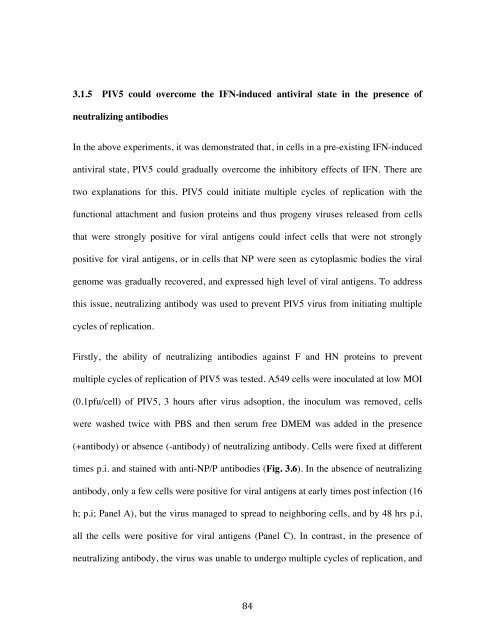Han Xiao PhD thesis - Research@StAndrews:FullText - University of ...
Han Xiao PhD thesis - Research@StAndrews:FullText - University of ...
Han Xiao PhD thesis - Research@StAndrews:FullText - University of ...
Create successful ePaper yourself
Turn your PDF publications into a flip-book with our unique Google optimized e-Paper software.
3.1.5 PIV5 could overcome the IFN-induced antiviral state in the presence <strong>of</strong><br />
neutralizing antibodies<br />
In the above experiments, it was demonstrated that, in cells in a pre-existing IFN-induced<br />
antiviral state, PIV5 could gradually overcome the inhibitory effects <strong>of</strong> IFN. There are<br />
two explanations for this. PIV5 could initiate multiple cycles <strong>of</strong> replication with the<br />
functional attachment and fusion proteins and thus progeny viruses released from cells<br />
that were strongly positive for viral antigens could infect cells that were not strongly<br />
positive for viral antigens, or in cells that NP were seen as cytoplasmic bodies the viral<br />
genome was gradually recovered, and expressed high level <strong>of</strong> viral antigens. To address<br />
this issue, neutralizing antibody was used to prevent PIV5 virus from initiating multiple<br />
cycles <strong>of</strong> replication.<br />
Firstly, the ability <strong>of</strong> neutralizing antibodies against F and HN proteins to prevent<br />
multiple cycles <strong>of</strong> replication <strong>of</strong> PIV5 was tested. A549 cells were inoculated at low MOI<br />
(0.1pfu/cell) <strong>of</strong> PIV5, 3 hours after virus adsoption, the inoculum was removed, cells<br />
were washed twice with PBS and then serum free DMEM was added in the presence<br />
(+antibody) or absence (-antibody) <strong>of</strong> neutralizing antibody. Cells were fixed at different<br />
times p.i. and stained with anti-NP/P antibodies (Fig. 3.6). In the absence <strong>of</strong> neutralizing<br />
antibody, only a few cells were positive for viral antigens at early times post infection (16<br />
h; p.i; Panel A), but the virus managed to spread to neighboring cells, and by 48 hrs p.i,<br />
all the cells were positive for viral antigens (Panel C). In contrast, in the presence <strong>of</strong><br />
neutralizing antibody, the virus was unable to undergo multiple cycles <strong>of</strong> replication, and<br />
<br />
84
















